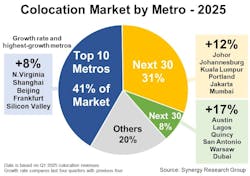Key Highlights
While 10 metros account for 41% of the world’s current colocation market, Synergy Research says Tier 2 metros are “reshaping the colocation market.”
Northern Virginia is the largest colocation market, accounting for 7% of the total.
The top ten colocation markets grew by 8% in 2024, the next thirty grew by an average of 12% and the following thirty by 17%.
While 10 metros account for 41% of the world’s current colocation market, Synergy Research says Tier 2 metros are “reshaping the colocation market.”
Today, Northern Virginia is the largest colocation market, accounting for 7% of the total.
Trailing Northern Virginia are Beijing, Shanghai and London, each accounting for around 5% of the total, and then Tokyo and New York at around 4% each.
"Proximity to customers remains a key driver of the colocation market, so data centers tend to be located in metros that have a large concentration of companies and economic activity,” said John Dinsdale, a Chief Analyst at Synergy Research Group. “Consequently, the markets in the top 10 have not changed since Synergy published a similar analysis a year ago, though there has been some movement in the ranking, with Shanghai having leapfrogged London.”
Tier 2 growth
Synergy noted that the top ten metros will see fluctuations; it is the next tier of metros that are seeing rapid growth.
While the top ten markets grew by 8% in 2024, the next thirty grew by an average of 12% and the following thirty by 17%. This group of sixty metros now accounts for 39% of the worldwide market.
Within the metros ranked 11-40, the markets that are growing the most rapidly are Johor, Johannesburg, Kuala Lumpur, Portland, Jakarta and Mumbai. Among the metros ranked 41-70, Austin, Lagos, Quincy, San Antonio, Warsaw, and Dubai are seeing new growth.
“What is more interesting is the much higher growth rate of many emerging markets,” Dinsdale said. “While the top ten have grown by an average of 8%, no less than 17 tier two metros have grown by 20% or more. This is a clear indication of how the market will evolve over the coming years, with rapidly developing markets becoming ever more important.”
US influence grows
Amidst the APAC and EMEA regions, Synergy found that a group of US tier two markets are finding ranking on the research group’s list.
Some of these markets include Columbus, Ohio; Minneapolis, Minnesota; Denver, Colorado; Salt Lake City, Utah; Charlotte, North Carolina; Phoenix, Arizona.
Tier 2 markets offer various benefits for data center builders and operators.
From a power perspective, a Tier 2 market offers lower per-kWh costs than Tier 1 cities. They also provide easier access to renewable energy sources like solar and wind as well as shorter timelines for substation deployment and interconnection.
One of the key Tier 2 highlights is Columbus, Ohio where Amazon Web Services is developing major campuses. Also, 200+ MW of colocation and hyperscale projects are underway.
Likewise, colocation providers like QTS and STACK Infrastructure are turning their attention to Tier 2 markets.
QTS, which is active in North Carolina, Illinois, and Oregon, is delivering scalable power blocks designed for hyperscale tenants.
STACK Infrastructure is developing large campuses in the Portland suburbs, Atlanta exurbs, and Phoenix-area secondary markets.
For related articles, visit the Data Center Topic Center.
For more information on high-speed transmission systems and suppliers, visit the Lightwave Buyer’s Guide.
To stay abreast of fiber network deployments, subscribe to Lightwave’s Service Providers and Datacom/Data Center newsletters.
About the Author
Sean Buckley
Sean is responsible for establishing and executing the editorial strategy of Lightwave across its website, email newsletters, events, and other information products.


